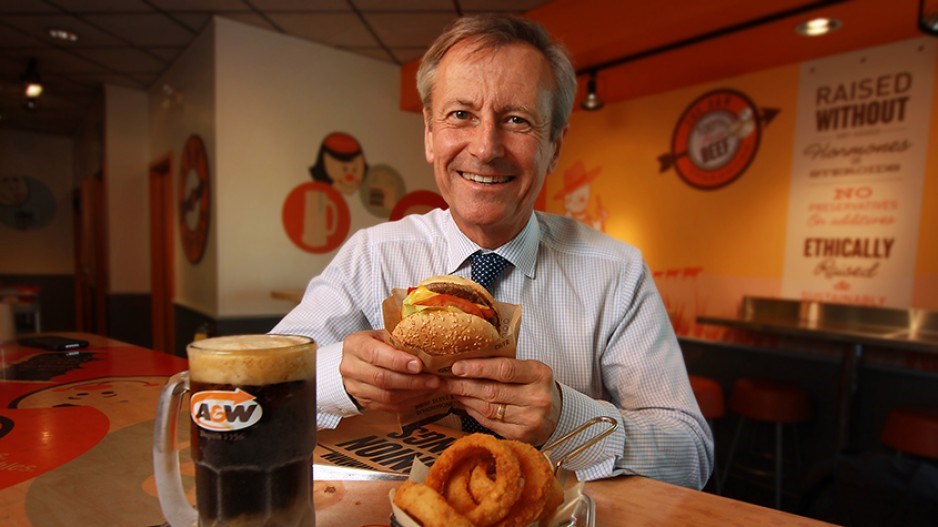Paul Hollands was born in 1956, the year A&W Food Services of Canada Inc. opened its first drive-in restaurant in Canada.
Twenty-five years later, drive-ins were disappearing as fast-food businesses relocated from roadsides to sit-down restaurants and enclosed shopping centres. Hollands, equipped with a bachelor of commerce from the University of British Columbia and a keen interest in marketing, looked at A&W and saw the “wonderful old brand” he loved as a kid in need of a makeover.
“[It] had this rich, deep, wonderful heritage,” Hollands said. “I remember joining and thinking, ‘This is really cool.’ There’s nothing greater for a marketer than getting to work on a grand old brand and trying to revitalize it.”
Hollands has spent 35 years doing exactly that, working in just about every division of A&W and, since 2005, serving as its CEO.
Working with the rest of the management team, he was part of the group that bought the brand from Unilever in 1995 and relaunched it as a franchise business. He helped renew its following among baby boomers such as himself who had grown up with it. Today, he’s once again overseeing a makeover targeting urbanites who give the brand a thumbs-up for its burgers made with meat produced without antibiotics and hormones.
“Consumers want hamburgers,” he said. “They love a hamburger; it’s a staple of the Canadian diet. But they really want to feel good about it when they eat one.”
A new focus on urban markets has meant that the company has “reached to a newer and younger guest,” he added. “It’s been transformational in terms of our business.”
Younger customers also mean being mobile-friendly, and among the latest initiatives is Guest Connect, a mobile app that allows customers to provide feedback on quality, service and cleanliness in seconds.
“One of the hallmarks of this business has been our willingness to keep changing it and changing it and changing it,” Hollands said. “You have to keep reinventing; it’s continual. And the minute you stop, it’s over.”
But change has never just been in terms of customer engagement.
Hollands’ work as CEO has involved steering the company through the changes to income trusts that the federal government announced in 2006. While other companies had set up income trusts to manage federal taxes, A&W Revenue Royalties Income Fund was set up in 2002 as a holding company for the brand’s assets. The operating company, A&W Food Services Canada, licensed those assets from the trust, making it more than a flow-through entity for tax purposes.
The structure worked, and, with a few minor changes, remains an integral part of managing the back end of one of Canada’s most popular fast-food brands.
Hollands said a long-term vision for the company, rooted in long-term management, has been helpful.
Born in Corner Brook, Newfoundland, and raised in the Vancouver Island community of Duncan, Hollands spent a year overseeing Shoppers Drug Mart’s trainee program prior to joining A&W in 1981. While his lengthy employment with the company is unusual in a world of immense change and employee turnover, it isn’t unusual at A&W. The average tenure among the company’s top management is 20 years.
“It’s tremendous for the business,” Hollands said. “Everyone thinks long-term. We respond with urgency in the short term, but we can think long-term,” he said. “We’re strategy-driven. We’re thinking three, five years out all the time.”
It’s also a business that facilitates the making of immediate connections with people and the establishment of long-term relationships.
“We open, say, 35 restaurants a year; well, 75% are opened with existing operators,” he said, noting that the company’s stability has fostered growth for several of the owners, many of whom he now counts as friends. “Some of them I’ve known for my whole 35 years working here.”
A&W itself now has almost 850 locations countrywide, and system-wide sales of more than $1 billion.
Ownership of the operating company is “very tightly held,” residing in current and retired members of the management team and one outside investor.
Hollands has no regrets about his time with the company, and while he’s had opportunities to work elsewhere, he has no plans to leave.
“It’s a fun business; it’s just been a fun business,” he said. “It’s a classic of good, strong management over a long period of time.”
A day in the life: Paul Hollands describes his typical timetable
5-7 a.m.: Run or gym workout
7 a.m.: At the office
7-8 a.m.: Clean up emails, organize the day
8-9 p.m.: Phone calls to Eastern Canada before they go to lunch
9 a.m.-noon: Either a video conference or in-house meeting with one of our teams working on a key strategic initiative
Noon-2 p.m.: Business lunch or lunch in one of our restaurants
2-5 p.m.: Meetings and phone calls in the office to deal with day-to-day issues in the business
5 p.m.: Home for evening with the family
Join us to celebrate on November 3 when Business in Vancouver and MacKay CEO Forums present the 2015 BC CEO Awards at the Fairmont Waterfront Hotel. For more information or to register for the event visit our events page.




